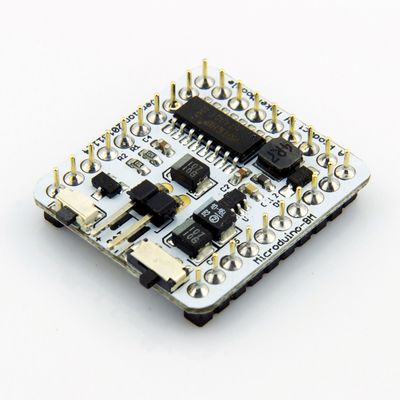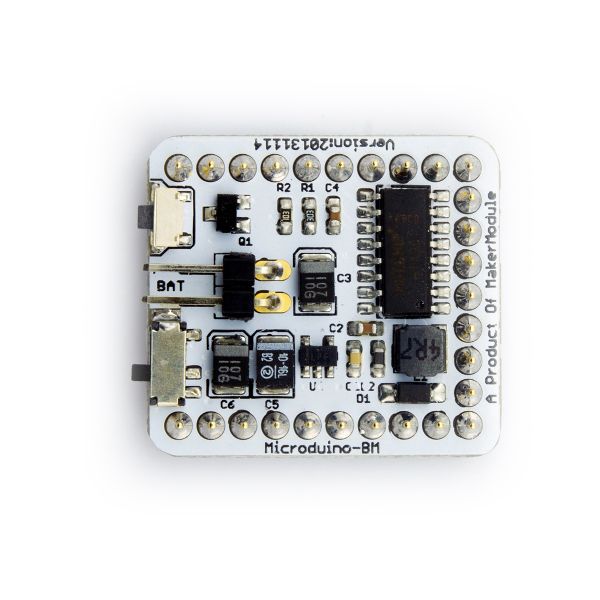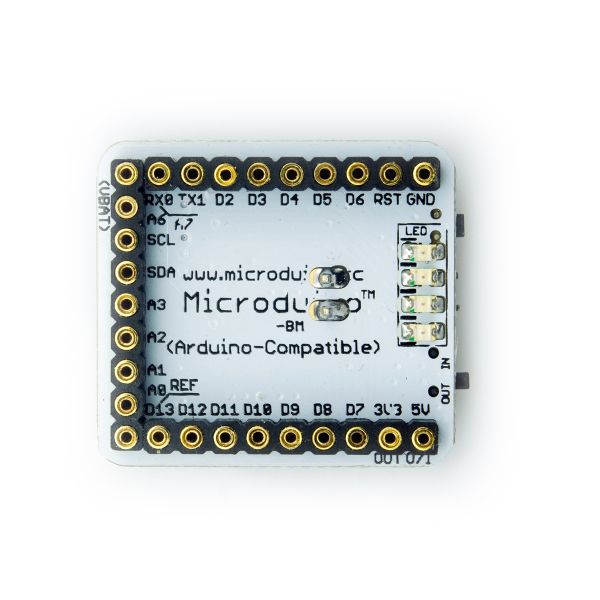Microduino-BM
| Language: | English • 中文 |
|---|
|
Microduino-BM is a discharging module which combines a single-cell Li-ion battery charge management, power detection and LED indication. The output voltage is 5V, and LDO is 3.3V output, providing the outstanding battery management for the Microduino-Core module.
| |
ContentsFeatures
| |
SpecificationsInterface
| |
Charging
| |
Discharging
| |
Power detection |
class="wikitable" |
| Undervoltage indication | 3.60V |
| Low-voltage protection | 2.40V |
| Indicator-off voltage when the voltage gets back. | 3.71V |
Low voltage indicator goes on under 3.60V and when the voltage keeps decreasing to 2.40V, the lithium battery protection circuit works. The indicator will go out when the battery is powered to 3.71V.
|- |
Standby
- Standby means that disconnect the circuit UPIN27's GND circuit. In this state, BM can be controlled within the overall power consumption of 30uA.
- Make sure the switch is in the "OUT", if no any action after accessing the battery, then the default mode is in standby mode.
- If you've turned on discharge mode,, pressing the button switch (3s above) to re-enter into standby mode.
- Intelligent Detection: No charge input, no discharge output (<10mA) within three minutes will enter into standby mode.
|- |
Documents
- Microduino-BM Eagle source file 【download】
- Microduino-BM main chips and devices
Main components
- Chip 1: HT4901 HT4901 Application guidelines Media: HT4901 Application guidelines V1.1.pdf
- Chip 2: LP2985AIM5X-3.3 Media:LP2985.pdf
- MOSFET: AO3400 Media:AO3400.pdf
- Schottky diodes: MBR0520 Media:MBR0520.pdf
- Toggle switch: MSK-12C01 (1P2T) Media:MSK-12C01(1P2T).pdf.
|- |
Development
- Battery: single-cell 3.7v li-ion battery;
- Recommended battery module is connected with 2PIN DuPont;
- Recommended power options: voltage 5V, current 600ma above, such as: computer USB, 5V phone charger.
|-
|
Applications
When viewing the board with the battery connector and switches closest to you, with the component side up, the battery connector positive (+) pin is on the left and the ground (-) pin is on the right. The pushbutton switch is on the left and the mode switch (IN = Charge, lever to the left; OUT = Discharge, lever to the right) is on the right.
After connecting the battery you must momentarily push the pushbutton switch to start the converter. You can stop the converter/turn off the power by unplugging the battery or by pressing and holding the pushbutton for a few seconds. To use the battery to generate +5 VDC and +3.3 VDC, set the mode switch (to the right of the battery connector when viewed as described above) to OUT (switch lever away from the battery connector). The IN position is used for charging the battery from an external 5VDC, >=600 mA source.
The charging current is 500 mA, so I recommend a battery with at least 500 mAH of capacity to avoid charging at a rate >1C.
A rough English translation of the charging process is as follows:
- Set the mode switch to OUT (switch lever away from the battery connector);
- Plug in the battery;
- Plug in the external 5VDC power supply (at least a 600 mA supply recommended);
- Set the mode switch to IN (switch lever toward the battery connector);
- When charging is complete as indicated by all 4 LEDs on, set the mode switch to OUT (switch lever away from the battery connector);
- Unplug the external 5VDC power supply.
The LED indications seem to be as follows, based on how Google Translate translates the Chinese datasheet for the HOTCHIP HT4901 at http://www.hotchip.com.cn/DownFiles/20131126090806453.pdf
Discharge Mode
Voltage LED1 LED2 LED3 LED4 3.2-3.5V ON OFF OFF OFF 3.5-3.65V ON ON OFF OFF 3.65-3.95V ON ON ON OFF > 3.95V ON ON ON ON
If the voltage drops below 3.2V, LED1 flashes and within 5 seconds the HT4901 goes to standby mode (I think... or should I say I hope...) to avoid over-discharging your battery.
Charge Mode
Voltage LED1 LED2 LED3 LED4 <3.4V FLASH FLASH FLASH FLASH 3.4-3.8V ON FLASH FLASH FLASH 3.8-4.0V ON ON FLASH FLASH 4.0-4.25V ON ON ON FLASH >= 4.25V ON ON ON ON
Be prepared to terminate the charging process immediately when all four LEDs are on and steady. Overcharging lithium-type batteries may result in a nasty fire. I don't know how good the HT4901 is at detecting that the charging process is complete and shutting off the charging current to the battery.
Hope I correctly translated this information.
|- |
Pictures
|- |
FQA
- Does this module can power on other Microduino modules?
- Yes, most modules can be power by this module, except the big power module, such as GPRS module.
- Does the BM module and USB module can work together to power on Microduino module?
- Don't suggest use them like this, but our new BM version will support UPS.
- Does this module is programmable and set its state by software?
- No, it isn't programmable.
- What the max range of voltage and current?
- 5V/500mA。
- Does this module can charge Li-ion battery?
- Yes.
- Do you have a module that can install a Li-ion battery?
- No.
- Does the Microduino module can use old mobile phone Li-ion battery.
- Yes.
History
November 14, 2013 new release, major improvements:
- Canceled VMOT pin, use the toggle switch directly and use the 5V port switching charge and discharge;
- Boost pushbutton can fully control the boost, UPIN27 the GND loop off.
- March 13, 2013 Batch completed.
- March 1, 2013 20130202 edition model released, testing is no big problem.
- February 2, 2013, using mobile power ASIC chip, re-layout.
- December 31, 2012, released the test panels, the main problems are:
- No 5V output;
- Battery Interface leakage;
- No power display.
|}


